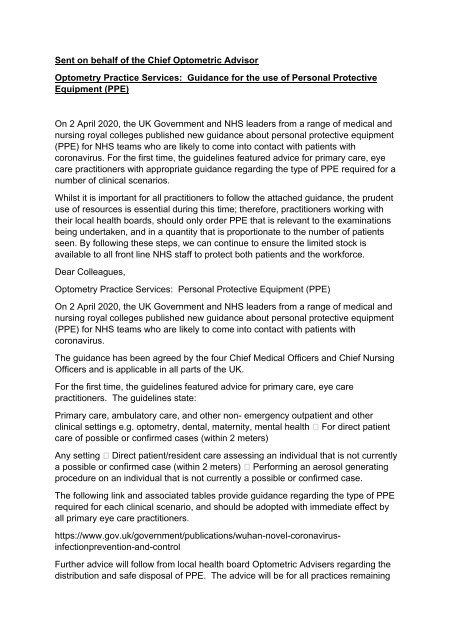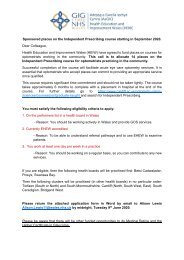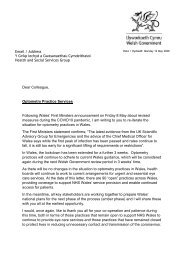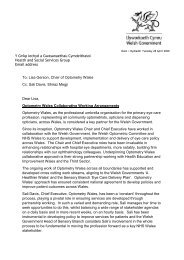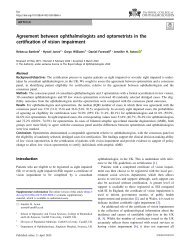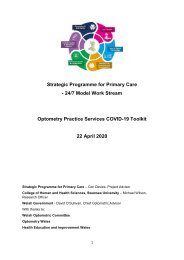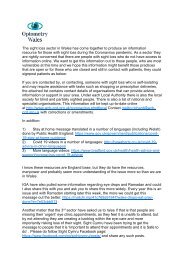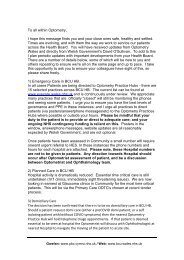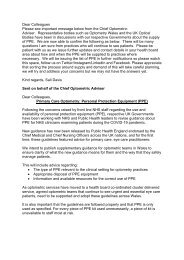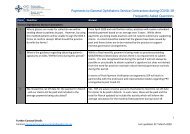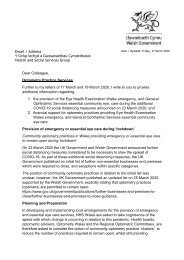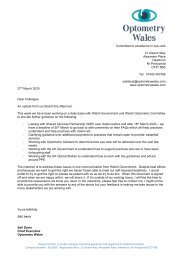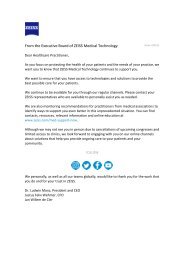PPE FAQs and Guidance from Chief Optometric Adviser
Create successful ePaper yourself
Turn your PDF publications into a flip-book with our unique Google optimized e-Paper software.
Sent on behalf of the <strong>Chief</strong> <strong>Optometric</strong> Advisor<br />
Optometry Practice Services: <strong>Guidance</strong> for the use of Personal Protective<br />
Equipment (<strong>PPE</strong>)<br />
On 2 April 2020, the UK Government <strong>and</strong> NHS leaders <strong>from</strong> a range of medical <strong>and</strong><br />
nursing royal colleges published new guidance about personal protective equipment<br />
(<strong>PPE</strong>) for NHS teams who are likely to come into contact with patients with<br />
coronavirus. For the first time, the guidelines featured advice for primary care, eye<br />
care practitioners with appropriate guidance regarding the type of <strong>PPE</strong> required for a<br />
number of clinical scenarios.<br />
Whilst it is important for all practitioners to follow the attached guidance, the prudent<br />
use of resources is essential during this time; therefore, practitioners working with<br />
their local health boards, should only order <strong>PPE</strong> that is relevant to the examinations<br />
being undertaken, <strong>and</strong> in a quantity that is proportionate to the number of patients<br />
seen. By following these steps, we can continue to ensure the limited stock is<br />
available to all front line NHS staff to protect both patients <strong>and</strong> the workforce.<br />
Dear Colleagues,<br />
Optometry Practice Services: Personal Protective Equipment (<strong>PPE</strong>)<br />
On 2 April 2020, the UK Government <strong>and</strong> NHS leaders <strong>from</strong> a range of medical <strong>and</strong><br />
nursing royal colleges published new guidance about personal protective equipment<br />
(<strong>PPE</strong>) for NHS teams who are likely to come into contact with patients with<br />
coronavirus.<br />
The guidance has been agreed by the four <strong>Chief</strong> Medical Officers <strong>and</strong> <strong>Chief</strong> Nursing<br />
Officers <strong>and</strong> is applicable in all parts of the UK.<br />
For the first time, the guidelines featured advice for primary care, eye care<br />
practitioners. The guidelines state:<br />
Primary care, ambulatory care, <strong>and</strong> other non- emergency outpatient <strong>and</strong> other<br />
clinical settings e.g. optometry, dental, maternity, mental health For direct patient<br />
care of possible or confirmed cases (within 2 meters)<br />
Any setting Direct patient/resident care assessing an individual that is not currently<br />
a possible or confirmed case (within 2 meters) Performing an aerosol generating<br />
procedure on an individual that is not currently a possible or confirmed case.<br />
The following link <strong>and</strong> associated tables provide guidance regarding the type of <strong>PPE</strong><br />
required for each clinical scenario, <strong>and</strong> should be adopted with immediate effect by<br />
all primary eye care practitioners.<br />
https://www.gov.uk/government/publications/wuhan-novel-coronavirusinfectionprevention-<strong>and</strong>-control<br />
Further advice will follow <strong>from</strong> local health board <strong>Optometric</strong> <strong>Adviser</strong>s regarding the<br />
distribution <strong>and</strong> safe disposal of <strong>PPE</strong>. The advice will be for all practices remaining
open as part of the health boards agreed cluster service arrangements. Practices<br />
operating outside of the agreed health board agreed cluster service arrangement<br />
would need to make separate arrangements to source <strong>and</strong> dispose of <strong>PPE</strong> safely.<br />
Working in reception / communal area with possible or confirmed case(s) <strong>and</strong><br />
unable to maintain 2 meters social distance<br />
Rydym yn croesawu derbyn gohebiaeth yn Gymraeg. Byddwn yn ateb gohebiaeth a<br />
dderbynnir yn Gymraeg yn Gymraeg ac ni fydd gohebu yn Gymraeg yn arwain at<br />
oedi.<br />
We welcome receiving correspondence in Welsh. Any correspondence received in<br />
Welsh will be answered in Welsh <strong>and</strong> corresponding in Welsh will not lead to a delay<br />
in responding.<br />
Please note, whilst it is important for all practitioners to follow the attached guidance,<br />
the prudent use of resources is essential during this time; therefore, practitioners<br />
should only order <strong>PPE</strong> that is relevant to the examinations being undertaken, <strong>and</strong> in<br />
a quantity that is proportionate to the number of patients seen. By following these<br />
steps, we can continue to ensure the limited stock is available to all front line NHS<br />
staff to protect both patients <strong>and</strong> the workforce.<br />
It is imperative that practitioners using <strong>PPE</strong> underst<strong>and</strong> how to use the equipment<br />
properly <strong>and</strong> safely. The local health board <strong>Optometric</strong> <strong>Adviser</strong>s will be available to<br />
provide further information <strong>and</strong> guidance for optometry practitioners required to use<br />
<strong>PPE</strong>, <strong>and</strong> all practitioners should ensure that they have completed the WOPEC<br />
distance learning lecture ‘COVID 19 : A central information point for Optometry<br />
practices in Wales’. The lecture access details will be emailed to all EHEW<br />
practitioners by 9am Monday 6 April 2020.<br />
The documents contained in the following links provides essential information, <strong>and</strong><br />
should be read in conjunction with the new guidelines.<br />
1. https://www.gov.uk/government/publications/covid-19-personalprotectiveequipment-use-for-non-aerosol-generating-procedures<br />
2. https://www.gov.uk/government/publications/covid-19-personalprotectiveequipment-use-for-aerosol-generating-procedures<br />
3. https://phw.nhs.wales/topics/latest-information-on-novel-coronaviruscovid19/information-for-healthcare-workers-in-wales/<br />
Coronavirus Q&A – personal protective equipment
Q What is personal protective equipment?<br />
Personal protective equipment (<strong>PPE</strong>) has been designed to help protect a person<br />
against health or safety risks at work <strong>and</strong> to prevent the spread of infection <strong>from</strong><br />
person to person via a heath or social care professional.<br />
It includes a wide range of items, including safety helmets, gloves, eye protection,<br />
highvisibility clothing, safety footwear <strong>and</strong> safety harnesses. It also includes<br />
respiratory protective equipment.<br />
<strong>PPE</strong> should be put on <strong>and</strong> removed in a specific order. The order for <strong>PPE</strong> removal is<br />
– gloves, apron or gown, eye protection, surgical facemask or FFP3 respirator. H<strong>and</strong><br />
hygiene must always be performed following removal of <strong>PPE</strong>.<br />
<strong>PPE</strong> is important to help stop the spread of coronavirus <strong>and</strong> to protect frontline<br />
healthcare workers. Coronavirus is spread primarily between people through close<br />
contact <strong>and</strong> droplets, not by airborne transmission.<br />
Q Are there different types of <strong>PPE</strong>?<br />
<strong>PPE</strong> comes in a number of different forms depending on where it is being used, for<br />
example for doctors <strong>and</strong> nurses, ambulance staff, maternity staff.<br />
Different types of <strong>PPE</strong> are used, according to the level of risk a person is exposed to<br />
in a particular setting or the procedure they are carrying out. For example, inserting a<br />
tube through a patient's mouth <strong>and</strong> into their airway <strong>and</strong> nebuliser treatments – a<br />
machine that delivers medicated mist to the lungs – poses a greater risk of exposure<br />
to the virus.<br />
Q What is the new guidance for <strong>PPE</strong> in relation to coronavirus?<br />
Updated guidance was published on 2 April 2020, following a rapid review by Public<br />
Health Engl<strong>and</strong> <strong>and</strong> the Academy of Medical Royal Colleges.<br />
The update has simplified the guidance in some places <strong>and</strong> reflects the fact<br />
coronavirus is now widespread in the community, meaning NHS <strong>and</strong> social care staff
are more likely to care for people with the virus, some of who will not yet have<br />
symptoms.<br />
The guidance states any clinician working in a hospital, primary care or community<br />
care setting who is within two metres of someone with suspected or confirmed<br />
coronavirus should wear <strong>PPE</strong> – an apron, gloves <strong>and</strong> a surgical mask, based on the<br />
risk.<br />
Q What are the changes in the new guidance?<br />
Three new tables have been added to clearly explain the <strong>PPE</strong> required for different<br />
common clinical scenarios – one table for hospitals <strong>and</strong> one for primary care,<br />
outpatient <strong>and</strong> community care <strong>and</strong> one for ambulance <strong>and</strong> first responders.<br />
A fourth table describes when to use <strong>PPE</strong> for all patient encounters – not just people<br />
with suspected or confirmed coronavirus – at a time when there is sustained<br />
community transmission <strong>and</strong> the likelihood of anyone having coronavirus infection is<br />
raised.


